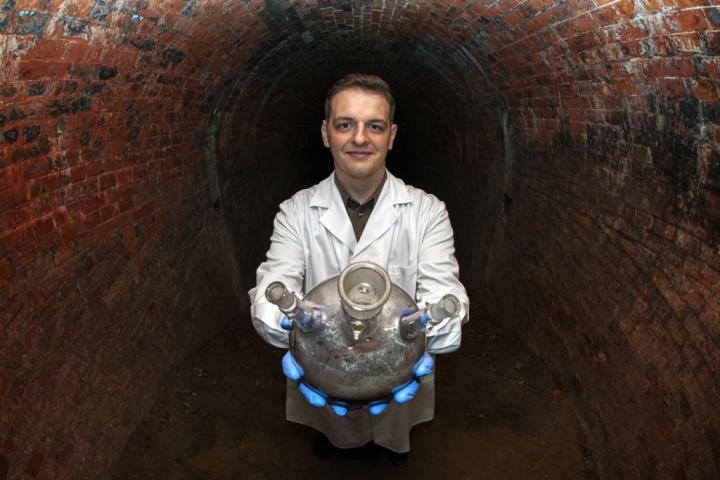Sep 10 2019
Treating water by sorption of organic solvents such as trichloroethylene (TCE) is not a new concept. But discovering a technique that neutralizes these pollutants, rather than just shifting them someplace, is not a simple task.
 The new nickel catalysts synthesized at the Institute of Physical Chemistry PAS allow for extremely effective water treatment in flow mode removing harmful organochlorine compounds. (Image credit: IPC PAS, G.Krzyzewski)
The new nickel catalysts synthesized at the Institute of Physical Chemistry PAS allow for extremely effective water treatment in flow mode removing harmful organochlorine compounds. (Image credit: IPC PAS, G.Krzyzewski)
A team guided by Anna Śrębowata, professor at the IPC has enhanced a technique of catalytic hydrotreatment, that is, converting TCE into hydrocarbons that are environmentally less destructive. Thanks to researchers from the IPC PAS, not only the water in the taps, but also in the rivers, can be safer and cleaner for human health.
Clean water is precious, but also a resource that is turning out to be very scarce. Various pollutants are prevalent, and some are very challenging to remove. Such pollutants comprise trichloroethylene (known in Poland as TRI). This organic solvent used to be frequently used in, amongst others, dry cleaners, organic syntheses, and for the industrial degreasing of metals while they are being processed. As a result of its negative impact, its use has been officially debarred since 2016.
However, in view of its stability, it may remain in both the soil and water for a number of years to come, explains MSc. Emil Kowalewski, a member of the team that formulated the novel technique of eliminating this compound from water. The project is part of a worldwide trend aimed at safeguarding water resources. The research may appeal to wastewater treatment plants and become a possible starting point for the creation of advanced water treatment systems. Why?
Present-day wastewater treatment plants are systems comprising many chemical, physical, and biological processes, but they efficiently remove mostly conventional pollutants. Others may stay in the water if their concentrations are sufficiently high.
“Meanwhile, trichloroethylene should not be in water at all, because it is mutagenic, carcinogenic, teratogenic...,” stated the scientist, “and what's more, extremely long-lasting. It accumulates and stays at the bottom of reservoirs, and since its solubility in water is very poor, it can remain harmful for many years to come.”
Today we deal with such compounds mainly by the process of sorption. However, in this way we're only transferring the threat from one place to another. An attractive solution seems to be catalytic hydrotreatment, i.e. transforming the TCE into less harmful hydrocarbons. However, in order to fully exploit the potential of this method, it was necessary to develop an efficient, stable and cheap catalyst.
Dr Anna Śrębowata, Professor, IPC
“Previously, we carried out research with palladium catalysts. They were effective but expensive, ”smiled Emil Kowalewski. The new nickel catalysts, created at the IPC PAS, enable an effective and low-cost method for performing the process of water treatment in flow mode, and simultaneously they are not difficult to synthesize.
“Using a catalyst in which nickel nanoparticles with a diameter of about 20 nm are deposited on the surface of activated carbon, we combine the sorption properties of carbon and the catalytic activity of nickel,” explained Emil Kowalewski.
In their study, the researchers from the IPC PAS also demonstrated that nickel nanoparticles deposited on activated carbon with a moderately ordered structure display higher activity and stability compared to a similar catalyst based on a support with an amorphous structure.
The researchers are, however, proudest of the novel element of their study—adding the flow technology to the water purification from TCE. Owing to this, the process parameters can be enhanced, the amount of waste can be minimized, and simultaneously catalysts which were inefficient or even unproductive in batch reactors (that is, where a particular batch of product is treated at one time) can be used.
This was the case with our nickel catalyst. Without flow technology its capacity to utilize TCE declined in time, the catalyst underwent poisoning. In the flow reactor, even after 25 hours, we did not observe any decrease in activity, although we conducted research on concentrations about 8000 times higher than the Polish standards of its content in drinking water.
Emil Kowalewski, MSc, IPC
Where can the advanced technique be applied? Particularly, in water and wastewater treatment plants. Wherever the water reaching the end user needs to be clean, irrespective of whether it is a user of tap water or a fish floating in the river.
Also, what should happen to the products of the hydrotreatment of water to eliminate trichloroethylene?
The resulting compounds are hydrocarbons, mainly ethylene. But it’s not enough for a banana maturation plant. It will simply escape.
Emil Kowalewski
“This publication is part of a project which has received funding from the European Union’s research and innovation programme ‘Horizon 2020’ under contract no. 666295 for co-financing and from funds for science in 2016-2019 allocated by the Ministry of Science and Higher Education for the implementation of an international co-financed project.”